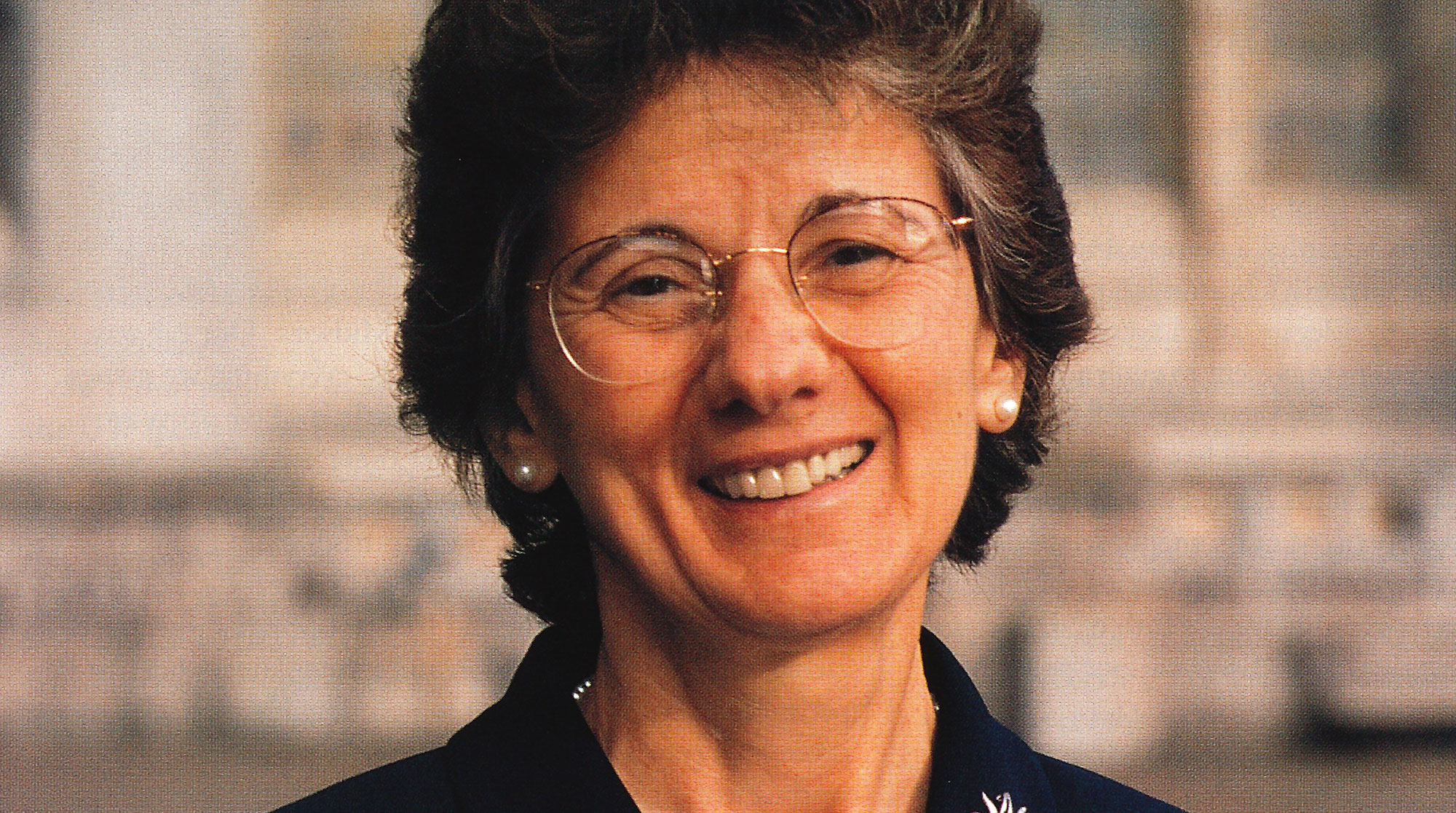

It was never Rita Rossi Colwell's goal in life to prove all the naysayers wrong: "Chemistry isn't for girls." "Fellowships aren't wasted on women." "Wives can't apply for positions at their husband's institutions." So forget for a moment that there are legions of former teachers, professors and advisers around the country who have eaten so much crow they need a Costco-sized bottle of Pepto Bismol. Spite was not her motivation.
Love was.
Specifically, it was her love of science. Ever since she was a peanut of a kid, she yearned to figure out how things worked. Her burning desire to understand the workings of life—first in chemistry, later in microbiology as a doctoral student at the University of Washington—gave her the gumption to brush past the doubters and overcome the lack of support to accomplish her goal of becoming a college professor. But she didn’t stop there.
Her insatiable curiosity, scientific ability and verve led her to become one of the world’s foremost authorities on cholera, president of the prestigious University of Maryland Biotechnology Institute, a member of the National Science Board, and the elected president of two other eminent organizations, the American Society of Microbiology and the American Association for the Advancement of Science.
With each step, she blazed new trails, even though that wasn’t her intent. Her list of being the “first woman to …” grew longer and longer, and now includes her current position on the Mount Everest of her field. She is the first woman (and first marine scientist) to serve as the director of the National Science Foundation, the preeminent scientific research organization in the land.
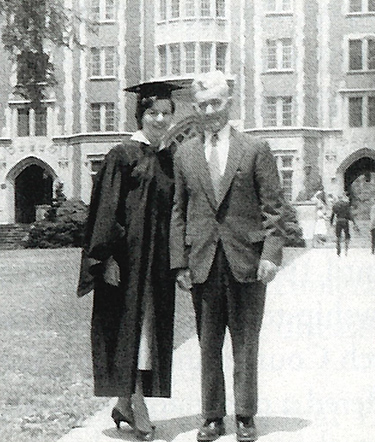
Colwell and her father, Louis Rossi, celebrate at her graduation from Purdue University in 1956. Photo courtesy of Rita Colwell.
Not too shabby for someone who was told over and over that science scholarships weren’t wasted on girls.
For her work, the University of Washington and the UW Alumni Association have bestowed upon her their highest honor: the 2000 Alumna Summa Laude Dignata award. She joins a distinguished list of alumni who, since 1938, have been honored as the alumnus of the year. Other winners include Seattle attorney and public servant James Ellis, ’48; science educator Shirley Malcom, ’67; artist Chuck Close, ’62; Nobel Prize winning biochemist Martin Rodbell, ’54; former Speaker of the House Tom Foley, ’51, ’57; and photographer Imogen Cunningham, ’07. It is the highest honor the UW bestows upon its graduates.
“In all her work.” says Denice Denton, dean of the UW College of Engineering, “she has demonstrated that she has tremendous initiative, determination, ability, and creativity to make an enormous contribution to society.”
Since taking over as director of the NSF, Colwell, who wakes up every morning at 5 to go jogging no matter what city she is in, hit the ground running. At her swearing in ceremony at the White House, an NSF staffer awed by Colwell’s 12-hour workdays pulled aside Colwell’s daughter, Alison, a Seattle government scientist, and asked, “Is she always like this? She has more energy than anyone we have ever seen.” Alison laughed. “Yes, she is always like this,” she said.
Under her leadership, the NSF has won significant budget increases from Congress and now President Clinton is asking for a 17 percent increase to strengthen core science and engineering disciplines while moving forward in interdisciplinary areas. (The NSF, an independent U.S. government agency, is responsible for promoting science and engineering through programs that invest more than $3.5 billion a year in nearly 20,000 research and education projects nationwide. NSF-funded research has led to such breakthroughs as magnetic resonance imaging, lasers, the Internet and Doppler radar.) She also unveiled a new initiative in “biocomplexity,” which examines the interaction of biological, physical and social systems on earth.
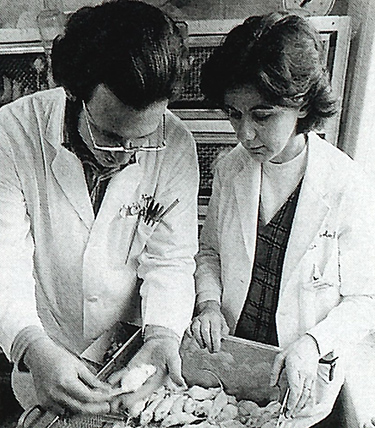
Colwell (right) and a graduate student at the University of Maryland examine a tray of mice injected with a Vibrio parahaemolyticus toxin, part of the early work on marine vibrios begun at the UW and continued at Maryland. Photo courtesy of Rita Colwell.
It’s obvious Colwell knows what she is doing. Her biocomplexity initiative has drawn more than 600 proposals for funding from universities around the country. In the past, a program drawing 100 proposals was thought to be doing well.
Her success is a vindication of sorts, since her background as a biologist is a significant break from the past at the NSF, where the vast majority of its previous directors were physicists and engineers. “Her appointment is recognition that we live in a biological world,” explains Jody Deming, a UW oceanography professor who was a graduate student under Colwell at the University of Maryland. “That is a vision that has been missing. She is putting the emphasis on the earth as a biological entity.”
She pulls it off with an arsenal of skills that include classroom smarts, research ability, administrative wizardry, a perpetual-motion work ethic, a near photographic memory, a bottomless pit of ideas and enthusiasm, an ability to delegate, and a political sense that is admired far and wide. “She has a unique ability to present to audiences ranging from Brownies to congressmen and their aides to fellow scientists,” remarks Gaylen Bradley, the vice president for academic affairs at the University of Maryland’s Biotechnology Institute.
Yet, if you ask Colwell (who went by the nickname “Ricky” during her time at the UW from 1957 to 1964), she had no such lofty aspirations as a youngster growing up the fifth of six kids in the seaside town of Beverly, Mass. “I was curious to see how things worked,” she says. “I loved nature.”
She and her family spent a lot of time at the ocean, puttering around tide pools. And though her parents (her dad was a construction worker, her mom a housewife) didn’t go to college, education was always stressed at home. At an early age, Colwell’s destiny was set. While a sixth-grader attending school in a four-room schoolhouse, she was called into the principal’s office after taking a standardized science test. “I was terrified,” Colwell recalls.
The principal sat her down, shook his finger at her and said, “You have a responsibility. You just got the highest score ever on this test. You have to go to college.”
Chemistry was her first love (girls weren’t even allowed to take physics then), but the straight-A student had her first encounter with the “glass ceiling” when her high school chemistry teacher told her not to bother with chemistry in college since it was not a profession for women.

Colwell and her husband, Jack, show off their second daughter, Alison, next to their Triumph TR-3 sportscar in 1963.
It’s too bad Colwell didn’t think to get a helmet then because she would bump her head on that glass ceiling many times in the next few years. She earned a full scholarship to Purdue University, and got a bachelor’s degree with distinction in bacteriology. Her goal was medical school, but first she set her sights on a fellowship to earn a master’s degree in bacteriology. Her department chairman denied her a fellowship because they “were not wasted on women.” By then, she had met a handsome fellow grad student named Jack Colwell, and they were soon married. Colwell ended up switching subjects to genetics, got her master’s degree, and she and her new husband were off to the University of Washington to pursue Ph.D. degrees—Jack in physical chemistry and she in microbiology.
“One of my fondest memories,” Colwell recalls, “was when Jack and I arrived from the Midwest. Our car was packed with books, clothes, records, everything we owned. We were so excited to come to Seattle, and we drove to Parrington Hall. This was before there was a ‘Red Square,’ and it was sunset. The sky was clear and Mount Rainier was so fabulously pink. This was our introduction to the UW. It was amazing.”
Despite the fact that she and Jack loved Seattle—especially racing dinghies on Lake Union and spring skiing—her first experiences at the UW were not so uplifting. Her first adviser, a prominent geneticist, gave her “no support,” although he seemed to find time to work with male graduate students. Eventually she found an adviser who would have a profound impact on her life—Microbiology Professor John Liston.
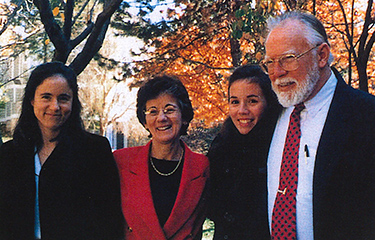
On the morning of her swearing in as director of the National Science Foundation, Colwell enjoys a moment with her family in front of her home in Bethesda, Md. From left are daughter Alison, Colwell, daughter Stacie and husband Jack.
Not your run-of-the-mill, old-school professor who treated graduate students like cheap labor, Liston gave his graduate students lots of rein. He trusted Colwell to outfit his new lab, order equipment, work with the carpenter, and set things up. He also expanded his students’ horizons, insisting they read authors such as James Thurber and Aldous Huxley and read about every subject under the sun—history, science fiction, humor, political science—in addition to their very serious work in the lab.
“Ricky was a self-starter from day one,” Liston recalls. “She needed very little supervision.” He recalls how she helped him build the scientific apparatus they needed for a course on aquatic microbiology, and how she would spend nights working in the basement of Bagley Hall on huge computers, writing codes and doing highly detailed statistical analysis of her research.
Colwell—who received her $170 monthly stipend at the UW from a $36,000 National Science Foundation grant—went on to become the first woman to earn a Ph.D. from the UW College of Oceanography. She also developed a reputation for trying innovative approaches and tackling unpopular theories—something that would serve her immensely well later in her career.
After earning her Ph.D. in 1961, she stayed on as a research professor at the UW until 1964, when her husband got a fellowship to join Canada’s National Research Council in Ottawa. Colwell was offered a postgraduate position of her own at the same agency, but at the last moment, the agency decided that its anti-nepotism rule prohibited it from offering fellowships to husbands and wives simultaneously.
So Liston came to the rescue, getting more NSF money to fund a position for her on the UW faculty, and then finagling a visiting professorship at the very Canadian agency that reneged on its offer to her. It was a lesson in ingenuity and loyalty that would leave an indelible impression with her.
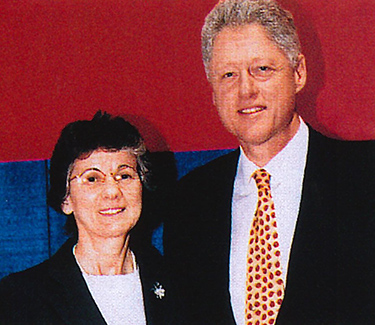
Colwell joins President Clinton at the American Association for the Advancement of Science meeting in Philadelphia in February 1998, shortly after the president nominated her to be NSF director.
“She is a very loyal person to everyone she meets,” says Bill Wiebe, ’65, a classmate of Colwell’s at the UW and now a professor at the University of Georgia. “She also remembers everyone and has a knack for getting people from different parts of the country together to work on great projects and ideas.”
After her two years in Canada, she joined the faculty of Georgetown University (she was that institution’s first woman faculty member in science), where she lasted until 1972, when the University of Maryland came calling.
By then, she had established herself as a major player in science. In the 1960s, she was the first researcher in the U.S. to develop a computer program to analyze bacteriological data.
While at Maryland, she spent most of her quarter century there proving to the scientific world that Vibrio cholerae, the causative agent of cholera, behaved far differently than everyone believed.
The conventional wisdom was that cholera was spread from person to person, primarily from people arriving in port cities on ships. In the 1800s, doctors didn’t really know what caused it or how to cure it. It was only in the mid-1800s that the world’s first epidemiological study—conducted by British physician John Snow—discovered that many victims had been drinking from the same well. It proved the connection to contaminated water supplies.
The search for a cure was intense because the disease was terrifying. The first cholera outbreak was recorded in 1817 in Persia and Turkey, killing thousands and leaving untold others sick. V. cholerae, which hit the Western Hemisphere in the 1830s, disrupts the transport of sodium and potassium in cells lining the intestines, causing diarrhea so severe that a person can lose more than 50 percent of his or her body weight, and death can occur in a matter of hours.
Scientists were pretty certain that cholera was spread by feces, food and water. But a vital question remained: what happened to the bacteria in between epidemics, when cholera seemed to disappear for years? And how could the disease strike different parts of the globe at the same time?
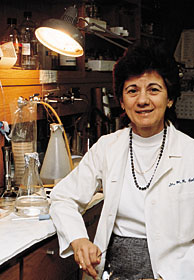
In addition to being NSF director, Colwell runs one of the world’s leading research laboratories on cholera at the University of Maryland. Photo courtesy of the University of Maryland.
Colwell came to believe that V. cholerae survived in the ocean. In the 1970s, she and her research team discovered the cholera bacterium in the waters of the Chesapeake Bay—a stunning fact, considering there were no outbreaks of the disease anywhere near the Chesapeake—or that the last cholera epidemic in the United States occurred in 1911. The idea that V. cholerae could exist in the waters off big U.S. cities was deemed preposterous.
The idea that the bug could exist in the environment without a human host, too, was considered just as absurd.
“We were excoriated,” Colwell recalls. ” ‘Nonsense,’ they told us. ‘It’s only transmitted from person to person.’ I was mocked and ridiculed by people who set themselves up as Colwell criticizers. It was not very nice, but you keep going.”
As it did years earlier, her stubbornness prevailed. More than 300 scientific research papers later, her ideas gained acceptance. “Unlike others who have studied pathogens,” explains James T. Staley, a professor of microbiology at the UW School of Medicine, “she looked at the natural habitat in which V. cholerae resides to determine how it lives away from its host. Her lab discovered that the organism resides in marine and estuarine waters by virtue of its ability to attach to and to grow in association with zooplankton.”
Her studies of the ecology and epidemiology of the bacterium in Chesapeake Bay were applied to India and Bangladesh, where cholera outbreaks are common. “Her studies have led to a recognition of the important environmental parameters associated with flooding that lead to outbreaks of the disease. Her research has combined ecology and epidemiology in a novel and important way that has led to a better understanding of how the disease can be controlled,” Staley adds.
By the mid-1900s, after cholera epidemics had circled the globe six times, water supplies and sanitation systems had been so improved that it appeared the disease was having less and less of an impact. Many began to think it would only plague developing nations.
Then in 1961, cholera returned with another pandemic. In 1991, it struck South America, where it had not been seen for more than 100 years. Colwell suspected that the bug persisted in an environmental reservoir—the ocean—as if waiting for the hosts to come along. She had found the bacteria in Chesapeake Bay (though no one believed her) and she wondered if it was just a matter that the bacteria couldn’t be seen—or that people hadn’t looked hard enough for it. Perhaps it was the traditional culture methods that weren’t working. “I wondered if it goes into a dormant state,” she says.
In the 1970s, a small cholera outbreak hit near New Orleans among people who had eaten crab from a local bayou. She went back to collect water samples, but this time, instead of doing a culture, she tried something new—using an antibody that would grab onto a key component of the bacterium’s cell membrane. A molecule in the antibody would light up under ultraviolet light. Sure enough, she was right. “We did a little tribal dance around the microscope,” she says. It showed the bacterium did go into a dormant state.
Besides her continuing work on cholera at her lab at the University of Maryland, Colwell is putting her considerable energy into being a teacher and mentor on the biggest stage: forging interdisciplinary research, promoting information technology, pushing an emphasis on learning science. It’s something she and Jack (a physicist) used at home in raising her two daughters, Alison (a fish disease specialist at the U.S. Geological Survey in Sand Point) and Stacie, now finishing an M.D./Ph.D. program. “I told my daughters they could major in whatever they wished, but they had to take math and calculus and two years of chemistry,” she says. “I wanted to expose them to science and see what opportunities were out there.”
Among the initiatives she is pushing is major system reform to improve science and mathematics learning in K-12, better teacher preparation, coordinated K-12 and college-level academic requirements to create a seamless education system and improved instructional materials.
She is also advocating more federal support for information technology and its links to the pursuit of basic scientific research. “This will be one of the most important ventures NSF can launch in the coming years,” she says. For instance, she cites the success of astronomers in developing computer-based methods to analyze data, such as surveys of the billions of stars in the sky.
Her fundamental belief is that boundaries between disciplines be dissolved, citing her own work on cholera. Her studies, for example, integrate data from oceanography, epidemiology, ecology, microbiology and clinical medicine.
“Only by bringing together multitudes of disciplines do you see the major advances that mean so much to society,” she explains. “We know magnetic resonance imaging emerged from chemistry and physics but we forget that they never would have become what they are without advanced mathematics. Doppler radar pushed the limits of atmospheric science, information science, and engineering—and opened up new frontiers in each.”
So the girl who was once told that science was not a profession for her gender carries on her crusade, excited at the future. Of those who snubbed her in the past, she only smiles. “Success,” she says, “is the best revenge.”